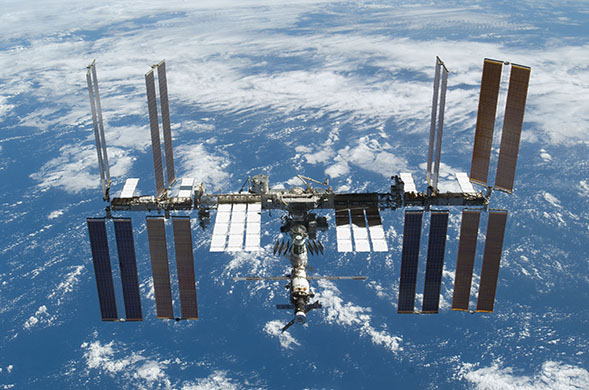Material Engineering in the Final Frontier
SDSU engineer Randall German is sending experiments to the International Space Station to improve fabrication techniques in space.

If humans are ever to colonize—or even just spend significant periods of time on—the moon or Mars, they’re going to need habitats, tools and other physical resources to keep them alive in the harshness of life away from our home planet. It would be impractical, cumbersome and wildly expensive to bring all the materials to build these resources from earth, so researchers are tinkering with ways to fabricate tools and building supplies from the raw minerals available on extraterrestrial terrain.“The idea is to send a vehicle in advance to harvest soils, mix the right composition and use heat to build bricks. That will eventually [lead to] the fabrication of habitats on the moon or Mars.”
Randall German, professor emeritus of mechanical engineering at San Diego State University, provided some insight into how space pioneers might accomplish that in a NASA teleconference earlier this week. The conference brought together a handful of scientists who are sending experimental materials to the International Space Station (ISS) aboard SpaceX’s reusable Dragon spacecraft on a resupply mission scheduled to launch in April.
German is the principal investigator for the Gravitational Effects on Distortion in Sintering experiment. Sintering is a manufacturing process that turns a powdered substance into a solid mass—a process called densification—using heat and pressure. When you fire ceramics in a kiln, for example, that’s sintering. It’s also used to convert metallic powders into solid metal, a process frequently used in toolmaking. SDSU researchers are among the world leaders in cutting-edge sintering research.
On earth, gravity distorts materials during the sintering process, forcing manufacturers to account for that distortion in their initial setup so the final sintered product comes out as planned. Microgravity environments, like those found on the moon and Mars, also cause distortions during sintering, but these are less understood.
To get a better understanding of how gravitational conditions in space affect the sintering process, German is sending up cartridges filled with various configurations of tungsten alloys that astronauts will place into a furnace aboard the ISS. After these alloys have undergone the sintering process in space, they’ll be sent back to earth on a later mission and returned to German so he can analyze the effects of microgravity.
He hopes to one day develop computer models that can predict how to shape an initial material so that when it’s sintered in microgravity, it comes out in the desired shape. In the future, that could allow human astronauts or robots to fashion their own materials for in-space repairs or to create building materials.
“The idea is to send a vehicle in advance to harvest soils, mix the right composition and use heat to build bricks,” German said during the teleconference. “That will eventually [lead to] the fabrication of habitats on the moon or Mars.”



